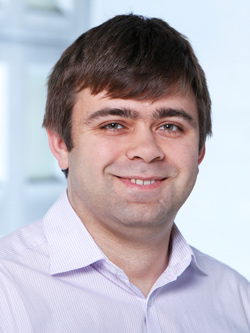
SPEAKER PROFILE |
 Prof. Maksym V. Kovalenko ETH Zürich, Department of Chemistry and Applied Biosciences & Empa-Swiss Federal Laboratories for Materials Science and Technology SWITZERLAND |
Novel Strategies for Combining Molecules, Clusters, and Nanocrystals into Functional Inorganic Solids
Abstract
Chemically synthesized inorganic nanocrystals are considered to be promising building blocks for a broad spectrum of applications including electronic, thermoelectric, and photovoltaic devices. To achieve high degree of electronic coupling, the nanocrystal packing, surface chemistry and surrounding medium need to be properly designed [1].
This talk will provide an overview of the most recent developments towards functional inorganic materials built from nanocrystal building blocks. Special attention will be paid to rational combinations of inorganic molecules, clusters and nanocrystals – from synthesis strategies and surface chemistry, to self-assembly and device applications. Several examples will include nanocrystal-based materials for Li-ion and Na-ion batteries [2,3,4], infrared-active nanostructures [5], and hybrid molecular-nanocrystal superlattices [6].
1. Kovalenko, M. V.; Scheele, M.; Talapin, D. V. Science 2009, 324, 1417.
2. Kravchyk, K.; Protesescu, L.; Bodnarchuk, M. I.; Krumeich, F.; Yarema, M.; Walter, M.; Guntlin, C.; Kovalenko, M. V. J. Am. Chem. Soc. 2013, 135, 4199.
3. He, M.; Kravchyk, K. V.; Walter, M.; Kovalenko, M. V. Nano Letters, 2014, 14, 1255.
4. M. I. Bodnarchuk, K. V. Kravchyk, F. Krumeich, S. Wang, and M. V. Kovalenko. ACS Nano, 2014, 8, 2360.
5. Yarema, M.; Kovalenko, M. V. Chem. Mater. 2013, 25, 1788.
6. Bodnarchuk, M. I.; Erni, R.; Krumeich, F.; Kovalenko, M. V. Nano Lett. 2013, 13, 1699.
This talk will provide an overview of the most recent developments towards functional inorganic materials built from nanocrystal building blocks. Special attention will be paid to rational combinations of inorganic molecules, clusters and nanocrystals – from synthesis strategies and surface chemistry, to self-assembly and device applications. Several examples will include nanocrystal-based materials for Li-ion and Na-ion batteries [2,3,4], infrared-active nanostructures [5], and hybrid molecular-nanocrystal superlattices [6].
1. Kovalenko, M. V.; Scheele, M.; Talapin, D. V. Science 2009, 324, 1417.
2. Kravchyk, K.; Protesescu, L.; Bodnarchuk, M. I.; Krumeich, F.; Yarema, M.; Walter, M.; Guntlin, C.; Kovalenko, M. V. J. Am. Chem. Soc. 2013, 135, 4199.
3. He, M.; Kravchyk, K. V.; Walter, M.; Kovalenko, M. V. Nano Letters, 2014, 14, 1255.
4. M. I. Bodnarchuk, K. V. Kravchyk, F. Krumeich, S. Wang, and M. V. Kovalenko. ACS Nano, 2014, 8, 2360.
5. Yarema, M.; Kovalenko, M. V. Chem. Mater. 2013, 25, 1788.
6. Bodnarchuk, M. I.; Erni, R.; Krumeich, F.; Kovalenko, M. V. Nano Lett. 2013, 13, 1699.
Bio
Maksym Kovalenko has been a tenure-track Assistant Professor of Inorganic Chemistry at ETH Zürich since July 2011. His group is also partially hosted by EMPA (Swiss Federal Laboratories for Materials Science and Technology) to support his highly interdisciplinary research program. He completed graduate studies at Johannes Kepler University Linz (Austria, 2004–2007, with Prof. Wolfgang Heiss), followed by postdoctoral training at the University of Chicago (USA, 2008–2011, with Prof. Dmitri Talapin). His present scientific focus is on the development of new synthesis methods for inorganic nanomaterials, their surface chemistry engineering and assembly into macroscopically large solids. His ultimate, practical goal is to provide novel inorganic materials for rechargeable Li-ion batteries, photovoltaics and optoelectronics. He is the recipient of an ERC Starting Grant 2012 and Ruzicka Preis 2013.